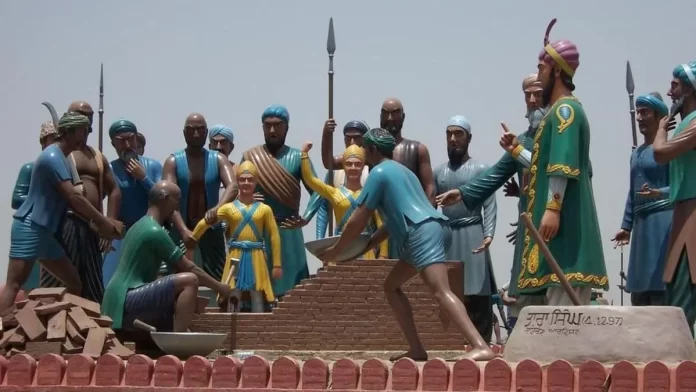Prime Minister Narendra Modi on Sunday declared 26th December as ‘Veer Baal Diwas’ in honor of the martyrdom of Sahibzada Zorawar Singh Ji and Sahibzada Fateh Singh Ji, the two minor sons of Guru Gobind Singh.
How did Zorawar Singh and Sahibzada Fateh Singh get martyred? What was the Battle of Anandpur and what is its significance?
Why were Rajput rulers of East Punjab against the rising influence of Guru Gobind Singh? Read this on till the end to learn more.
Battle of Anandpur
The battle of Anandpur took place in Anandpur between 10th Sikh Guru Gobind Singh and Hindu Rajput rulers of the eastern hilly areas of Punjab.
The Guru had taken refuge in the relatively safe hilly terrains of Anandpur after being routed off the plains of Punjab by Mughals.
However, the Rajput rulers of the area felt threatened by Guru’s presence in their region and were concerned about his rising power and influence there.
Consequently, they along with the rulers of Jammu, Nurpur, Mandi, Kullu, Guler, Chamba, Srinagar, and Dadhwal, etc formed a military alliance to forcibly oust Guru Gobind Singh’s authority from the area.
Having gathered enough forces and resources, they besieged Anandpur and asked the Guru to pay some outstanding dues and vacate Anandpur. When the Guru refused, a deadly war broke out between the two sides.
Later the Mughals and a large number of Ranghars and Gujjars, under the command of Jagatullah, joined the Rajput rulers.
The Great Betrayal
The Guru withheld the attack for days until he ran out of the stocks of food and fodder in the town.
Left with no other choice, Guru Gobind Singh was forced to retreat and he agreed to leave peacefully.
After being assured of a safe passage by Rajputs and Mughals, he left Anandpur with a few of his family members and servants.
Meanwhile, he entrusted his two minor sons Sahibzada Jorawar Singh (aged 9 years) and Sahibzada Fateh Singh (aged 7 years) with his wife Mata Gujri, in the care of his cook Gangu.
Gangu, however, betrayed Guru and treacherously handed over Mata Gujri and the two Sikh Sahibzadas to Mughal law enforcement.
They were subsequently arrested and brought before Wazir Khan, the Mughal Fauzdar and Governor of Punjab in the garrisoned town of Sirhind.
Martyrdom of two Sahibzadas
According to Historians when the Governor asked Fateh Singh, what he would do if freed, the latter replied, “Fateh Singh ke Jathe Singh”, meaning that he would gather an army of Sikhs under his command to fight him.
Nevertheless, the Governor was impressed with both Sikh Princes and wished them to revert to the Islamic faith.
Not much is known about what happened afterward, but according to Sikh and Brahmanical accounts, it was an absolute tragedy.
The two minor sons of the 10th Sikh Guru Gobind Singh were sentenced to a horrible death.
They were allegedly bricked alive in the walls of Sirhind on the orders of Wazir Khan, the Mughal Governor after their refusal to embrace Islam. Some say Dewan Suchanand was responsible for their death and not the Governor.
However, Mughal and Persian historians of those times are generally silent on this issue.
Hostilities between Sikhs and Mughals
With respect to the hostilities between Sikhs and Mughals, some Persian accounts of those times suggest that Mughals fell suspicious of Guru’s hostile and military-style maneuvering in Punjab.
While some Mughal Emperors, in general, had cordial relations with some Sikh Gurus, others especially the devout Aurangzeb viewed them as apostates and heretics.
He allegedly ordered the execution of the 9th Sikh Guru Tegh Bahadur Singh on similar charges.
Also Read| Why did Mughals Kill Guru Tegh Bahadur, the 9th Sikh Guru?
Sikhs also retaliated whenever they got the opportunity. For instance, Banda Singh Bahadur slaughtered several Mughal cities like Samana and Mukhlisgarh during his military campaigns.
In 1710, Sikhs captured Sirhind after the Battle of Chappar Chiriin and killed Wazir Khan and Dewan Suchanand who they held responsible for the martyrdom of the two youngest sons of Guru Gobind Singh.
Sirhind was later renamed Fatehgarh Sahib in the honor of Sahibzada Fateh Singh, the fourth and youngest son of Guru Gobind Singh.
Public Reactions to Government’s Move
While many welcomed the government’s move to mark the martyrdom day as Veer Baal Diwas, some also raised apprehensions about the timing and intent of the central government in light of the upcoming Punjab polls.
Many also viewed it as an attempt of the government to placate Punjabi Sikhs who had been at the forefront of the farmer’s protests which forced the government to withdraw three controversial farm laws.
For example, Siromani Akali Dal objected to the government’s unilateral decision of naming the Shahidi Diwas of Chhote Sahibzade without consultation with the Shiromani Gurdwara Parbandhak Committee (SGPC), which manages Sikh places of worship.
“I strongly oppose naming Shaheedi Diwas of Sahibzaade as Veer Bal Diwas. Babas are being reduced to children. Govt has no business reinterpreting our beliefs in a reductionist way,” tweeted SGPC member Kiranjot Kaur.
